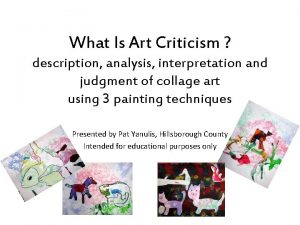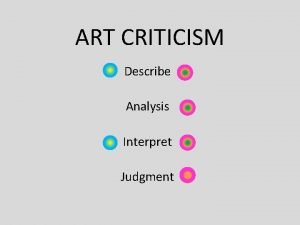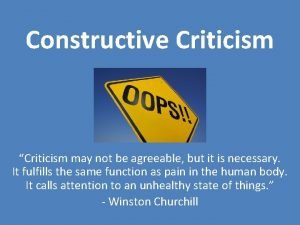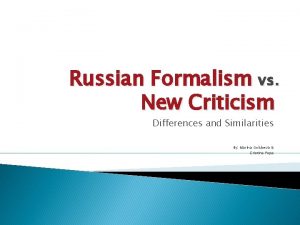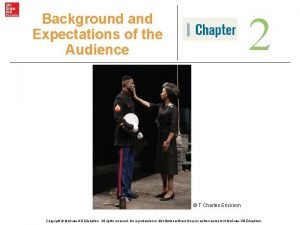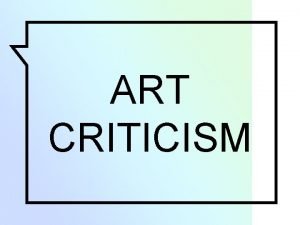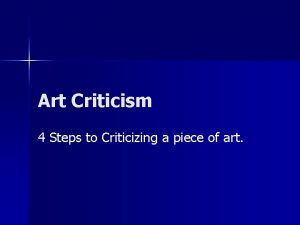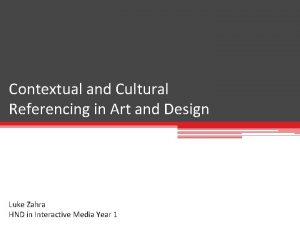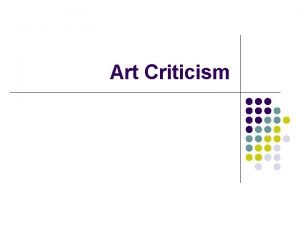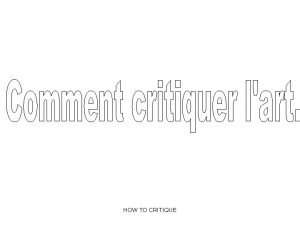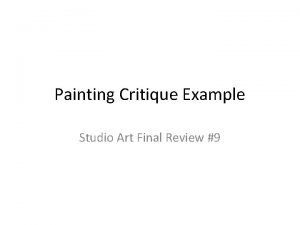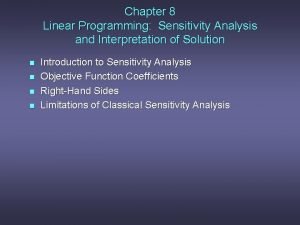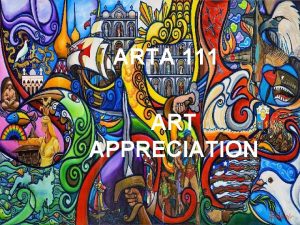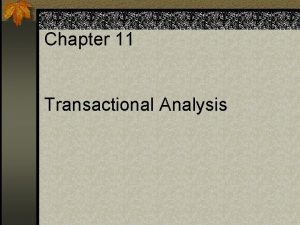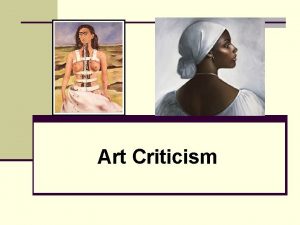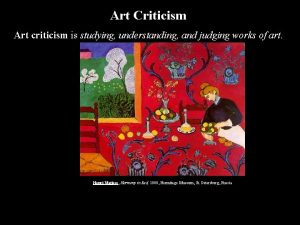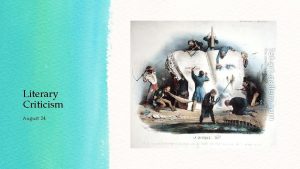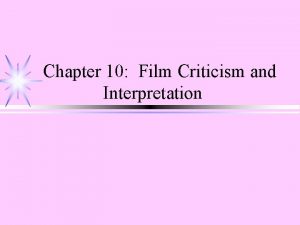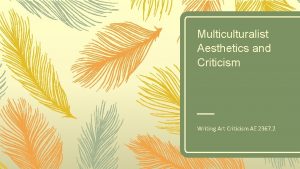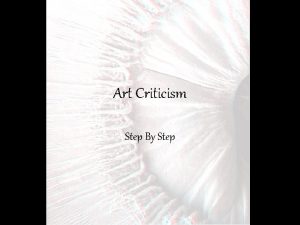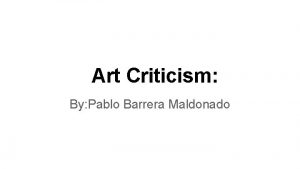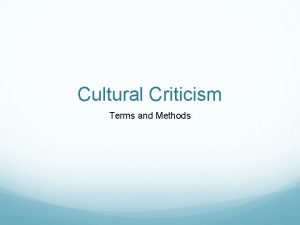What Is Art Criticism description analysis interpretation and



























- Slides: 27

What Is Art Criticism ? description, analysis, interpretation and judgment of collage art using 3 painting techniques Presented by Pat Yanulis, Hillsborough County Intended for educational purposes only

How Can you Figure Out Art? COPY THIS CHART Describe Analyze Interpret Judge “What do you see? ” "How did the artist do it? ” "Why did the artist create it and what does it mean? ” “Is it a good artwork? ” Description = pure listing of the object or objects you see. Analysis = discussion of the elements of art and principles of design Interpretation = discovering the main idea for this type of art. Judgment = giving it rank in relation to other works and consider its originality.

Description = What Do I See? What Kind of Art? Painting X Photograph Sculpture X X Print Pottery X

Description = Identification of Objects What do you see? How is it placed? 1. Farm workers 1. Horizontal 2. Picnickers 2. Landscape 3. Wheat field 4. Tree

Description = What Do I See? What Medium is used? Paint X Film Paper Clay Steel X X X

Analysis = How Did The Artist Do It? Using the Elements of Art! They are the building blocks of an artistic creation, a "visual language" or "visual alphabet" used by the artist.

Analysis = using the elements of art to organize the work • Line – a continuous mark made on a surface • Shape – two-dimensional (circle, square, rectangle, triangle) and encloses space • Form – three-dimensional and encloses and takes up space • Color – that which is perceived when light hits and reflects off an object. Three properties of color are Hue (name of a color), Intensity (strength of a color) and Value (lightness or darkness of a color) • Texture – the surface quality or feel of an object • Space – the illusion of space is created through light and shadow

Analysis = Using the Elements of Art How did the artist do it? Line – a continuous mark made on a surface .

Analysis = Using the Elements of Art How did the artist do it? • Shape – two-dimensional (circle, square, rectangle, triangle) and encloses space

Analysis = Using the Elements of Art How did the artist do it? Form – three-dimensional and encloses and takes up space

Analysis = Using the Elements of Art • Color – that which is perceived when light hits and reflects off an object. Three properties of color are Hue (name of a color), Intensity (strength of a color) and Value (lightness or darkness of a color)

Analysis = Using the Elements of Art How did the artist do it? …WITH THE THREE PROPERTIES OF COLOR: HUE VALUE INTENSITY name of a color lightness or darkness of a color strength of a color

Analysis = Using the Elements of Art How did the artist do it? . . . using … Texture – the surface quality or feel of an object

Analysis = Using the Elements of Art How did the artist do it? Using … Space – the area above, below, around and between an artwork; it is created through light and shadow

Analysis = Using the principles of design How did the artist do it? . . . using the Principles of Design! -the ways in which the color, line, shape, form, texture and space are organized.

Analysis = Using the Elements of Art PRINCIPLE OF DESIGN EXAMPLE DEFINITION Rhythm and movement visual flow through a work of art, using repetition Balance symmetry and asymmetry Proportion large next to small Variety the use of different or contrasting elements to add interest Emphasis used to make something stand out, like dark next to light Unity how all the aspects of a work of art work together

Interpretation of Art = main idea What Is the Artist Trying to Communicate? Can I express what I think the artwork is about in one sentence?

Judgement= Is It a Successful Artwork? Judging a piece of work means giving it rank in relation to other works and considering its originality. What do I think makes it a good artwork?

Directions for Marbling Technique • Marbling Applications and Techniques • • • EQUIPMENT NEEDED Containers and stirrers for paint. Combs with long prongs. Purchase or make by pushing T pins into a 1 " wide strip of corrugated cardboard and taping over their tops. The teeth should be evenly spaced and long enough to pierce the surface of the paint floating on the surface Eye Droppers : One for each color used. Pans: Cake pans, aluminum roasting pans or photographic trays that are 1 -2" deep. Newspaper Strips cut 2" wide for skimming excess paint from the size after marbling. Wastebaskets next to the marbling area. Paper Towels for clean up. cardstock • • Liquitex Medium Viscosity Concentrated Artist Colors: They are recommended for marbling, as they are fluid and easily mix with water. Needs to be thin. All colors can be intermixed. The following colors have been found to work consistently: Burnt Sienna, Brilliant Yellow, Permanent Alizarine Crimson Hue, Phthalo Green, Ultramarine Blue, Titanium White, Dioxazine Purple, Prism Violet, Phthalo Blue, Cerulean Blue Hue, Turquoise Green, Bright Aqua Green, Permanent Green Deep, Chromium Oxide Green, Bright Yellow Green, Yellow Medium, Azo, Yellow Orange, Azo, Yellow Light Hansa, Yellow Oxide; Deep Magenta and Red Oxide. Liquitex Marble Ease: A medium that enables all Medium Viscosity Colors to spread rather than pool on the size surface. Size: A suspension mixture, which the paint floats on. Traditionally tragacanth or carrageenan, are added to water to thicken it. Blue Liquid starch or powdered laundry starch can also be used. Not all brands of liquid starch work.

Marbling Technique What Do You see?

Art Criticism: Describe what you see. bird’s head and beak. ) (I see a

Directions for Bubbling Technique • • Instructions – Measure and pour 2 cups of Dawn Dishwashing Detergent and 1 cup of tempera into a bowl. – Mix the bubble solution and paint together with a spoon until they are thoroughly blended. Test the color of the solution by blowing a bubble on a piece of paper. Add more paint to deepen the color or more bubble solution to lighten it. – Pour the bubble solution into a rectangular pan and blow bubbles in the solution with a straw. Lay a piece of paper over the bubbles to make your print.

Art Criticism: Description –What Do You See? Use one table for the bubble blowing with one group of 4 -5 students • THE OTHER TABLES SHOULD BE BUSY LOOKING FOR FOUND OBJECTS! “I see a burro’s head. ” “I found a crab. ”

Bubbling Technique : What Do You See? “I see a stuffed bunny. ” “I see a girl riding a duck. ”

Directions for Straw Painting Now what do you see? • Instructions – Drip a little watercolor paint, any color, on the paper. Use a teaspoon if it's easier. A bright primary color such as red, yellow or blue works well. – Drip your second color on another spot on the paper. Then dab your third on yet another spot. Take the straw and show your student how to blow a color so the paint spreads out, usually forming one or more thin lines across the paper. Do the same with the other colors. Materials Cardstock, straw (one per child), watercolor, brush to drip colors

Straw Painting Technique • See what you can find in these paintings.

We searched and traced …didn’t have to worry about drawing… Then we cut out what we found…then we described, we analyzed, interpreted and judged… our collages!
 Description analysis interpretation judgement
Description analysis interpretation judgement Art judgement example
Art judgement example 4 steps in art appreciation
4 steps in art appreciation Learn something
Learn something What is the difference between new criticism and formalism
What is the difference between new criticism and formalism Historical criticism definition
Historical criticism definition Descriptive criticism vs prescriptive criticism
Descriptive criticism vs prescriptive criticism How does interpretation b differ from interpretation a
How does interpretation b differ from interpretation a Mararenko
Mararenko Steps of art criticism
Steps of art criticism 4 step art criticism
4 step art criticism Contextual references in art and design
Contextual references in art and design Define the four steps of art criticism.
Define the four steps of art criticism. Art critique steps
Art critique steps Contemporary framework meaning
Contemporary framework meaning Critique of a painting example
Critique of a painting example Example of analysis and interpretation of data
Example of analysis and interpretation of data Example of analysis and interpretation of data
Example of analysis and interpretation of data Range of feasibility
Range of feasibility Chapter 4 presentation of data
Chapter 4 presentation of data What is deductive coding
What is deductive coding Data analysis and interpretation examples
Data analysis and interpretation examples Nnrims
Nnrims Data analysis, interpretation and presentation
Data analysis, interpretation and presentation Humanus meaning in art
Humanus meaning in art Child ego state
Child ego state Thermogravimetric analysis theory
Thermogravimetric analysis theory Vertical analysis interpretation
Vertical analysis interpretation
